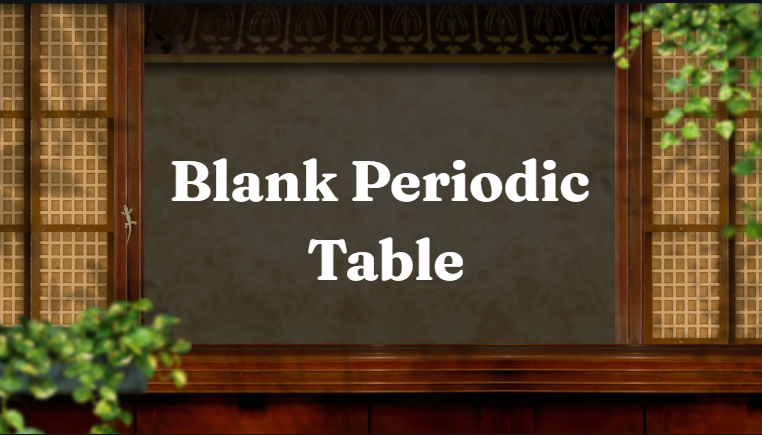A blank periodic table is a simple, empty version of the periodic table of elements. It does not include the names, symbols, or atomic numbers of the elements. Instead, it provides a basic layout where you can write, label, and learn about the elements yourself. This tool is very useful for students, teachers, and chemistry learners who want to test their memory or practice filling in element information.
A blank periodic table is not just an empty chart—it’s a great learning tool that helps build a strong understanding of the structure of elements and their relationships.
2. What Is a Blank Periodic Table?
A blank periodic table is a template that shows the arrangement of all chemical elements without any data. The boxes are empty, allowing students to fill in the information such as:
- Element name
- Atomic number
- Chemical symbol
- Atomic mass
- Group and period numbers
This helps learners study and memorize the periodic table in an active and fun way.
3. Importance of a Blank Periodic Table
A blank periodic table has many educational benefits. Here are some reasons why it’s important:
- Active Learning – Instead of just reading or looking at a periodic table, students write the information themselves, which helps memory.
- Test Preparation – It’s a great practice sheet for exams, especially in chemistry and science tests.
- Understanding Element Positions – Learners can see how elements are grouped and related by their properties.
- Teaching Aid – Teachers use it in classrooms to make learning interactive.
Using a blank periodic table is one of the best ways to build strong recall and understanding of chemical elements.
4. Features of a Blank Periodic Table
A blank periodic table can vary in design, but most have the following features:
- Rows (Periods): There are 7 horizontal rows representing the energy levels of atoms.
- Columns (Groups): There are 18 vertical columns representing families of elements.
- Empty Boxes: Each box represents an element position.
- Labels for Groups or Periods: Some tables include group numbers and period numbers to guide students.
Some versions also leave space for adding atomic mass or electron configuration, depending on what the user wants to learn.
5. How to Use a Blank Periodic Table
Here are some simple ways to use a blank periodic table effectively:
- Practice Filling in Element Symbols: Write down all the element symbols (like H for Hydrogen, O for Oxygen).
- Add Atomic Numbers: Fill in the correct atomic numbers from 1 to 118.
- Color Coding: Use colors to group elements (for example, metals in one color and nonmetals in another).
- Quiz Yourself: Cover the filled table and try recalling each element.
- Label Groups: Write names like “Alkali Metals,” “Noble Gases,” or “Halogens” for better understanding.
This simple activity improves both speed and accuracy when learning the periodic table.
6. Types of Blank Periodic Tables
There are several types of blank periodic table templates available for different purposes:
- Basic Blank Table: Only includes boxes and layout.
- Numbered Template: Includes atomic numbers but no symbols or names.
- Grouped Template: Divided into color sections for metals, nonmetals, and metalloids.
- Interactive Digital Template: Used online where students can click and type element data.
Each type can be used depending on your learning level and preference.
7. Benefits of Using a Blank Periodic Table
Here are the top benefits of using a blank periodic table for study and teaching:
- Improves Memory: Helps you remember element names, symbols, and numbers.
- Enhances Understanding: Teaches how the periodic table is organized.
- Encourages Active Learning: Makes learning more engaging and less boring.
- Boosts Exam Performance: Students can recall data faster during tests.
- Supports Teachers: Teachers can easily assess student learning through practice sheets.
In short, it transforms a complex chart into a simple learning exercise.
8. Printable Blank Periodic Tables
Many websites offer printable blank periodic tables in PDF format. You can easily download and print them for school or home use. Some printable versions are:
- Labeled template (with group numbers)
- Unlabeled version (completely blank)
- Colored versions for visual learning
- Black-and-white for simple printing
Printable blank periodic tables are ideal for homework, quizzes, and classroom activities.
9. Tips for Students
Here are some helpful tips for students using a blank periodic table:
- Start with first 20 elements before moving to all 118.
- Use flashcards to remember symbols.
- Practice filling the table daily for a few minutes.
- Use mnemonics (memory tricks) for remembering element sequences.
- Check your work with a full periodic table to correct mistakes.
With regular practice, you’ll quickly master the elements and their positions.
10. Conclusion
A blank periodic table is more than just an empty sheet—it’s a powerful study aid that builds understanding and memory. It helps students actively engage with chemistry and understand how the periodic system works. Teachers can also use it to make lessons more interactive and effective.
Whether you are a student preparing for exams or a teacher designing activities, a blank periodic table is a simple yet smart tool for mastering chemistry fundamentals.
FAQs
Q1. What is the use of a blank periodic table?
A blank periodic table helps students practice and memorize element symbols, names, and positions.
Q2. Can I print a blank periodic table?
Yes, many websites offer free printable blank periodic tables in PDF format for school or personal use.
Q3. Is a blank periodic table good for beginners?
Absolutely! It’s perfect for beginners as it encourages active participation and learning.
Q4. How can I make a blank periodic table more fun?
Use colors, drawings, or stickers to mark element groups and make learning more visual.
Q5. Can teachers use it for classroom quizzes?
Yes, teachers often use blank periodic tables for class tests, quizzes, and homework assignments.


